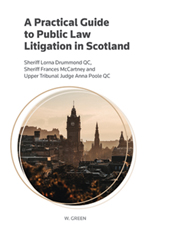Review: A Practical Guide to Public Law Litigation in Scotland
 Terra Firma’s new call Jon Kiddie reviews a much needed day-to-day practical book on judicial review.
Terra Firma’s new call Jon Kiddie reviews a much needed day-to-day practical book on judicial review.
Published at the very end of 2019, this is an excellent book, and worthy of recommendation to a broad range of readers: law students, solicitors, solicitor advocates, and counsel — whether their interest be peripheral, or whether they routinely practise in the arena of judicial review or similar.
It is also a book that is well overdue in Scotland. The most recent new books dedicated to this country’s law of judicial review (which has certain peculiarities) were Aidan O’Neill’s brilliant Judicial Review in Scotland: A Practitioner’s Guide, and Lord Clyde & Denis Edwards’ scholarly Judicial Review. Both of those were published in 1999, and are still frequently referred to in practice. That said, given the panorama of significant historical, legislative and jurisprudential landmarks that have occurred since their publication, in a JR context, 1999 feels as though it was back when the Earth was still cooling. It was, after all, only five years after the launch of the new Chapter 58 of the Rules of the Court of Session. And, since then, we’ve had the Scotland Acts, the entry into force of the Human Rights Act 1998, the Tribunals, Courts & Enforcement Act 2007, the Courts Reform (Scotland) Act 2014, Brexit, the Miller cases, and the prorogation debate (to name but a few crucial events).
In the interim, of course, Scots judicial review has continued to receive some valuable treatment in legal literature. One notable example is the weighty loose-leaf Court of Session Practice, as edited by the Lord President and a host of others. Its Division H, Chapter 2 is devoted to JR, and regularly updated. Another is Charles Hennessy’s excellent Civil Procedure and Practice, which is now in its 5th edition (2018), where the author always gives JR its place in the Scottish legal landscape. And, of course, there’s Greens Annotated Rules and Practice Notes.
However, such is the enormous and fast-developing nature of JR, that non-specialist texts can only ever give it partial discussion.
In England, there is a greater variety of reading material, and some of the keystone specialist tomes do undergo regular updating, e.g. De Smith’s, which is now in its 8th edition with supplements. The English literature can be enormously useful for substantive law, where there is considerable cross-over between jurisdictions. However, overall, its utility is limited. For example, one of the aforesaid peculiarities of Scots JR is that it recognises a right of action in respect of the decision-making processes of two private bodies, whereas English JR does not. And, of course, the two countries operate procedures that are distinct from each other.
However, A Practical Guide to Public Law Litigation in Scotland is a very different animal from the likes of Aidan O’Neill’s book and that of Clyde & Edwards. Its first feature of note is its size. Its principal content comes to 190 pages (excluding foreword, introduction, and tables of contents, cases, statutes and statutory instruments), whereas O’Neill’s takes up 400 pages, and Clyde & Edwards even more. This is by no means a negative criticism of the new book. On the contrary, its length renders it accessible. Its principal content can be read and understood comfortably in a day (albeit perhaps not entirely absorbed). If one skips the footnotes, this time is halved. That said, the new book’s most striking features are: (a) it’s a book about judicial review that isn’t a book about judicial review; (b) it’s a practical guide (and it really is); and (c) it’s pretty much up-to-date (although, for how long we’ll just have to wait and see).
As the label on the front of the tin says, so to speak, this is a book about public law litigation, and JR doesn’t appear in its title, or even on its cover at all. Obviously, much of its content is devoted to JR, and ‘judicial’ and ‘review’ are the first two words of its principal content. However, it swiftly moves on to speak about the other various forms of procedure for challenging public decision-making processes, e.g. shrieval summary applications, statutory appeals, and even ombudsman complaints etc. This is a very welcome acknowledgement of these other procedures, which too often receive inadequate attention in the teaching of JR (to the extent that sometimes they are almost entirely overlooked despite their actual practical importance in real life litigation).
And, although this is a book about public law, it does also recognise said distinctly Scottish species of JR for challenging private decision-making (albeit, understandably, it doesn’t examine this in a lot of detail, given its primary concern is public law). It’s a practical guide in a way that practitioners really are going to find tremendously helpful, especially those who are relatively new to this arena. For example, not only does it discuss procedure clearly yet in detail (and, in so doing, deal with the innovations introduced by the 2014 Act, such as time limit and permission), but it even contains quite comprehensive sections on financing petitions through legal aid and crowdfunding, and it explores Protective Expenses Orders in a lot of detail. Its appendices are also not simply afterthoughts, but extremely valuable in their own right: table of Protective Expenses Orders up to November 2018 (No Kingsford Stadium Ltd v Aberdeen City Council); procedural flowchart; and styles for Petition and Answers.
O’Neill’s Practitioner’s Guide was an extremely learned and detailed examination of substantive law, and thus academic in intent and feel. It was never a book that could be read in a day. By contrast, this new book is a ‘Practical Guide’ for practitioners. That said, by no means does it give substantive law short shrift. For example, its table of cases contains some 19 pages (the 1999 book has 26), which are, of course, up-to-date as towards the end of 2019. For example, it has an entire section on the practical implications of Eba v AG for Scotland. Moreover, almost every page of its principal content has footnotes that explore rules and jurisprudence in greater depth (sometimes very considerable depth). However, it is clear that its authors (all of whom possess significant experience in public law and now hold judicial office) have put a lot of careful thought into the book’s structure. The result is an extremely pleasing product. It can beread in as much or as little detail as its audience needs or wants, or as their circumstances dictate. For example, as said, one could skip the footnotes, digest the large text in half the time, yet still walk away from the experience with an enriched and well–rounded appreciation of this important arena of practice.
‘A Practical Guide to Public Law Litigation in Scotland’ won’t teach you everything that you need or want to know, and the other books mentioned, and others besides, remain important. However, this is an extremely useful addition to our legal bookshelves, and an excellent resource for our toolkits.
I heartily recommend this book.
A Practical Guide to Public Law Litigation in Scotland. Published by W.Green, (£59.00 Hardback) 264pp.








